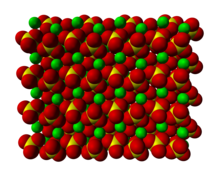Strontium sulfate

| |
| Names | |
|---|---|
| IUPAC name
Strontium sulfate
| |
| Other names | |
| Identifiers | |
3D model (JSmol)
|
|
| ChemSpider | |
| ECHA InfoCard | 100.028.955 |
| EC Number |
|
PubChem CID
|
|
| UNII | |
CompTox Dashboard (EPA)
|
|
| |
| |
| Properties | |
| SrSO4 | |
| Molar mass | 183.68 g/mol |
| Appearance | white orthorhombic crystals |
| Density | 3.96 g/cm3 |
| Melting point | 1,606 °C (2,923 °F; 1,879 K) |
| 0.0135 g/100 mL (25 °C) 0.014 g/100 mL (30 °C) | |
Solubility product (Ksp)
|
3.44 x 10−7 |
| Solubility | insoluble in ethanol, alkalis slightly soluble in acids |
| −57.9·10−6 cm3/mol | |
Refractive index (nD)
|
1.622[2] |
| Structure | |
| Orthorhombic, oP24 | |
| Pnma, No. 62[3] | |
| Thermochemistry | |
Std molar
entropy (S⦵298) |
117.0 J·mol−1·K−1 |
Std enthalpy of
formation (ΔfH⦵298) |
-1453.1 kJ·mol−1 |
| Hazards | |
| NFPA 704 (fire diamond) | |
| Flash point | Not flammable |
| Safety data sheet (SDS) | External MSDS data |
| Related compounds | |
Other anions
|
Strontium chloride Strontium oxide |
Other cations
|
Beryllium sulfate Magnesium sulfate Calcium sulfate Barium sulfate |
Except where otherwise noted, data are given for materials in their standard state (at 25 °C [77 °F], 100 kPa).
| |
Strontium sulfate (SrSO4) is the sulfate salt of strontium. It is a white crystalline powder and occurs in nature as the mineral celestine. It is poorly soluble in water to the extent of 1 part in 8,800. It is more soluble in dilute HCl and nitric acid and appreciably soluble in alkali chloride solutions (e.g. sodium chloride).
Structure
[edit]Strontium sulfate is a polymeric material, isostructural with barium sulfate. Crystallized strontium sulfate is utilized by a small group of radiolarian protozoa, called the Acantharea, as a main constituent of their skeleton.
Applications and chemistry
[edit]Strontium sulfate is of interest as a naturally occurring precursor to other strontium compounds, which are more useful. In industry it is converted to the carbonate for use as ceramic precursor and the nitrate for use in pyrotechnics.[4]
The low aqueous solubility of strontium sulfate can lead to scale formation in processes where these ions meet. For example, it can form on surfaces of equipment in underground oil wells depending on the groundwater conditions.[5][6]
References
[edit]- ^ Lide, David R. (1998). Handbook of Chemistry and Physics (87 ed.). Boca Raton, FL: CRC Press. pp. 4–87, 1364. ISBN 0-8493-0594-2.
- ^ Patnaik, Pradyot (2003). Handbook of Inorganic Chemical Compounds. McGraw-Hill. pp. 560–576. ISBN 0-07-049439-8. Retrieved 2009-06-06.
- ^ Krystek, M. (1979). "Lattice Parameters of (BaxSr100-x)SO4 Doped with Europium". Physica Status Solidi A. 54 (2): K133. Bibcode:1979PSSAR..54..133K. doi:10.1002/pssa.2210540256.
- ^ J. Paul MacMillan, Jai Won Park, Rolf Gerstenberg, Heinz Wagner, Karl Köhler, Peter Wallbrecht “Strontium and Strontium Compounds” in Ullmann's Encyclopedia of Industrial Chemistry 2002, Wiley-VCH, Weinheim. doi:10.1002/14356007.a25_321.
- ^ Jacques, Donald F.; Bourland, Brent I. (1983). "A Study of Solubility of Strontium Sulfate". Society of Petroleum Engineers Journal. 23 (2): 292–300. doi:10.2118/9625-PA.
- ^ Dean, S. W.; Ezuber, Hosni M. (2007). "Prediction of Strontium Sulfate Scale Formation in Oilfield Environment". Journal of ASTM International. 4 (6): 100958. doi:10.1520/JAI100958.

